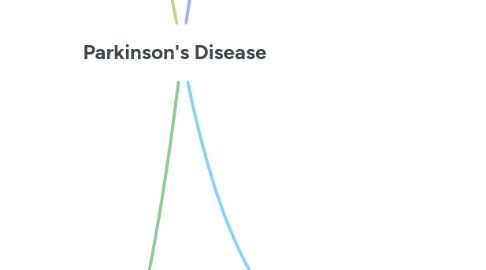
1. Pathophysiology and Etiology
1.1. Parkinson's Disease (PD) is a chronic, progressive neurodegenerative condition that predominantly impacts the dopaminergic neurons in the substantia nigra of the brain.
1.2. The pathological process entails the degeneration of dopamine-producing neurons in the pars compacta of the substantia nigra, leading to diminished dopamine levels in the striatum and altering basal ganglia circuits that regulate movement (Marras et al., 2020).
1.3. Lewy bodies, abnormal clumps of the protein alpha-synuclein, accumulate in neurons, leading to cellular malfunction and death (Espay et al., 2017).
1.4. The etiology is complex, primarily idiopathic, however associated with genetic mutations (e.g., SNCA, LRRK2, PARK2 genes) and environmental factors (e.g., pesticides, heavy metals) (Kalia & Lang, 2015).
1.5. Risk Factors: Age >60 years Male gender Family history of Parkinson's Disease Rural living or well water exposure History of traumatic brain injury Occupational exposure to herbicides/pesticides (DeMaagd & Philip, 2015)
2. Signs and Symptoms & System Impact
2.1. Systemic Impact Cardiovascular: Orthostatic hypotension due to autonomic failure Gastrointestinal: Delayed gastric emptying, constipation Cognitive/Neuropsychological: Executive dysfunction, hallucinations Pulmonary: Aspiration risk from dysphagia, leading to pneumonia (Bloem et al., 2021)
2.1.1. Complications: Falls and fractures Aspiration pneumonia Malnutrition Medication-induced dyskinesia Caregiver burden and depression
2.2. Motor Signs/Symptoms: Resting tremor (often “pill-rolling”) Bradykinesia (slowness of movement) Muscular rigidity Postural instability Gait disturbances (shuffling walk, stooped posture)
2.2.1. Non-Motor Symptoms: Cognitive impairment/dementia Depression, anxiety Sleep disturbances (REM sleep behavior disorder) Autonomic dysfunction (constipation, orthostatic hypotension) Fatigue, anosmia, urinary urgency
3. Diagnostic Tests and Labs
3.1. Clinical Diagnosis: Asymmetry of motor symptoms Good response to levodopa Presence of tremor at rest
3.2. Imaging: DaTscan (Dopamine Transporter SPECT): to confirm presynaptic dopaminergic deficit (Sasaki, 2017) MRI/CT: Often normal; used to exclude structural brain pathology
3.3. Olfactory Testing: Loss of smell is a common early feature. Cognitive Testing: MMSE or MoCA for assessing cognitive decline. No specific blood tests confirm PD, but labs may be used to rule out metabolic or infectious causes of Parkinsonism.
4. Treatment Options: Medications and Referrals
4.1. Pharmacologic Management Levodopa/carbidopa: the most effective bradykinesia and stiffness treatment, although long-term use may cause motor fluctuations and dyskinesia. Pramipexole, ropinirole: Dopamine agonists Often recommended for younger patients (<65 years) to delay levodopa introduction and lessen dyskinesia risk. These may produce hallucinations or impulse control issues. MAO-B inhibitors (selegiline, rasagiline): A mild clinical benefit may be neuroprotective. Often given alone or with levodopa in early illness. Entacapone, opicapone: prevents peripheral breakdown of levodopa to lengthen its duration. Amantadine: Reduces levodopa-induced dyskinesias in advanced illness and has moderate antiparkinsonian effects. Anticholinergics (e.g., trihexyphenidyl, benztropine) are mostly treated for resting tremor in younger patients (<60 years) with predominant tremor and minor bradykinesia or rigidity. Due to cognitive adverse effects (memory loss, confusion, hallucinations), not recommended for elderly persons.
4.1.1. Non-Pharmacologic Therapies Physical therapy: Gait training, strength maintenance Occupational therapy: ADL support Speech therapy: Swallowing and speech clarity Psychotherapy: For depression and anxiety
4.1.1.1. Surgical Intervention Deep Brain Stimulation (DBS): For advanced disease with motor complications unresponsive to medications.
4.1.1.1.1. Referrals Neurologist specializing in movement disorders – for ongoing medication management and disease progression monitoring. Physical therapist – to maintain strength, mobility, and balance. Occupational therapist – to assist with ADLs and recommend adaptive equipment. Speech-language pathologist – for speech clarity and swallowing assessments. Social worker – to help coordinate care services and provide caregiver support. Skilled home health nurse – for medication management, wound care (if present), and overall health monitoring at home. Home health aide or shower aide – to assist with personal hygiene, bathing, and mobility support during ADLs.
